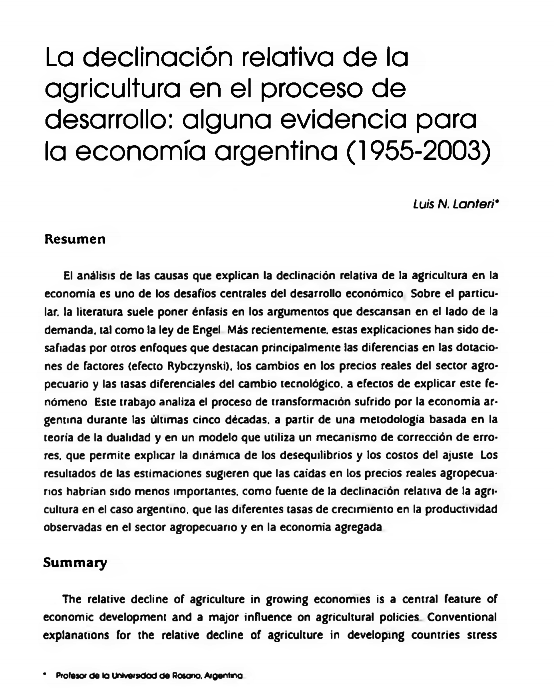The relative decline of agriculture in the development process: some evidence for Argentinian economy (1955-2003)
DOI:
https://doi.org/10.35319/lajed.20054267Keywords:
Agriculture, Rybczynski effect, Relative pricesAbstract
The relative decline of agriculture in growing economies is a central feature of economic development and a major influence on agricultural policies. Conventional explanations for the relative decline of agriculture in developing countries stress demand-side phenomena, specifically Engel's law. This view has been challenged by quantitative analyses emphasizing supply-side effects such as differences in factor endowment growth rates (Rybczynski effect), the changes in the relative price of sector and differential rates of technical change. This paper shows a model of the transformation of the argentine economy, applying duality theory and a error correction mechanism to capture the dynamics resulting from disequilibrium and the costs of adjustment .The decline in agriculture's share of gross domestic product is found to be caused less by the relative price effects than by technical change observed in agriculture and in total economy.
Downloads
References
Anderson K. 1987. “On why Agriculture declines with Economic Growth”. Agricultural Economics. (3). 195-207.
Caselli. F. y W Coleman 2001. “The U.S. Structural Transformation and Regional Convergence: a Reinterpretation”. Journal of Political Economy. (109). 584-616.
Chenery H. Robinson S. y M. Syrquin 1986. Industrialization and Growth: a Comparative Study. Oxford University Press.
Engle R y C Granger 1987. “Co-integration and Error Correction representation. Estimation and Testing”. Econometria (55). 251-276
Diewert. E y C Morrison 1988 “Export Supply and Import Demand Functions a production Theory Approach” En R. Feenstra Empirical Methods for International Trade MIT Press.
Gollin. D. S. Parente y R Rogerson 2002. “The Role of Agriculture in Development” American Economic Review Papers and Proceedings (92). 160-164.
Johansen. S 1988 “Statistical Analysis of Cointegration Vectors” Journal of Economic Dynamics and Control. (12). 231-54
Johnston. B. y J. Mellor 1961 “The Role of Agriculture in Economic Development” American Economic Review. (51). 566-593.
Kohli. U 1991. Technology. Duality and Foreign Trade: the GNP Function Approach to Modeling Imports and Exports. University of Michigan Press.
Lewis. W. 1954. Economic Development with Unlimited Supplies of Labor. Manchester School.
Martin. W. y P. Warr. 1993. “Explaining the Relative Decline of Agriculture: a Supply-side Analysis for Indonesia” The World Bank Economic Review. (7). 381-401.
Punyasavatsut. C. y I. Coxhead. 2002. “On the Decline of Agriculture in Developing Countries: a Reinterpretation of he Evidence”. University of Wisconsin-Madison. Mimeo.
Rybczynski. T. 1955. “Factor Endowments and Relative Commodity Prices”. Economica. (22). 336-41.
Timmer. P. 1988. “The Agricultural Transformation”. En H. Chenery. Y T. Srinivasan (eds). Handbook of Development Economics. Vol. 1. North-Holland.
Woodland. A. 1982. “International Trade and Resource Allocation”. North-Holland.






